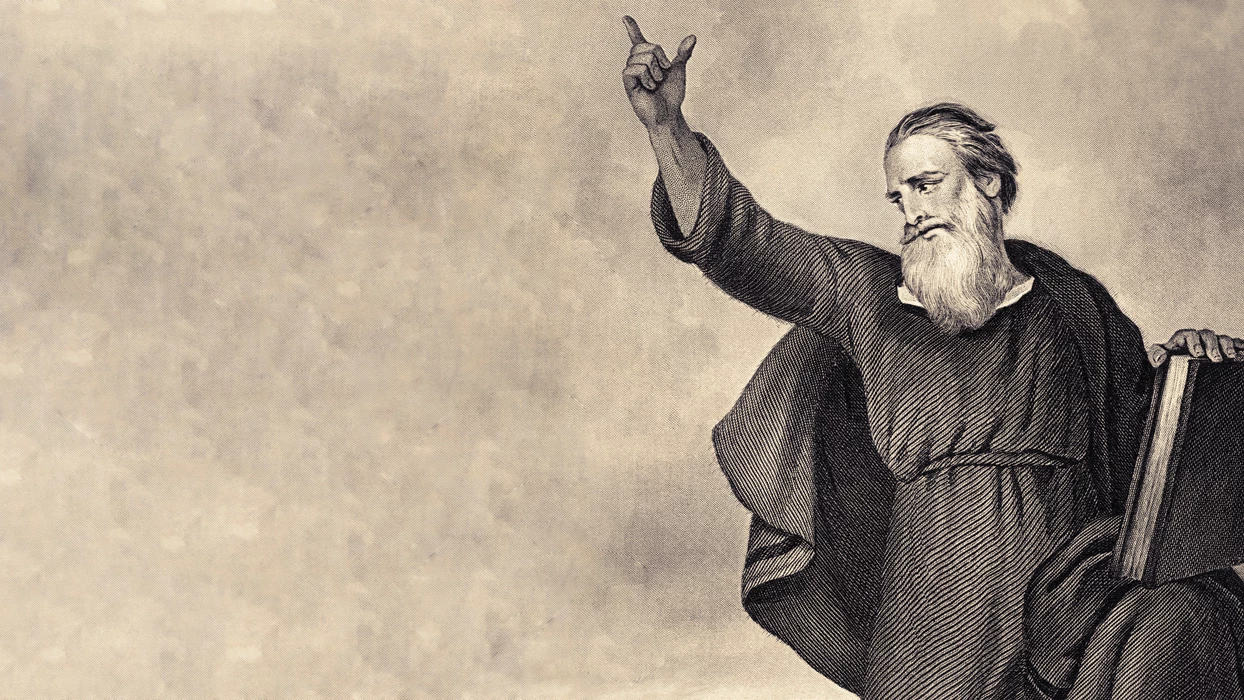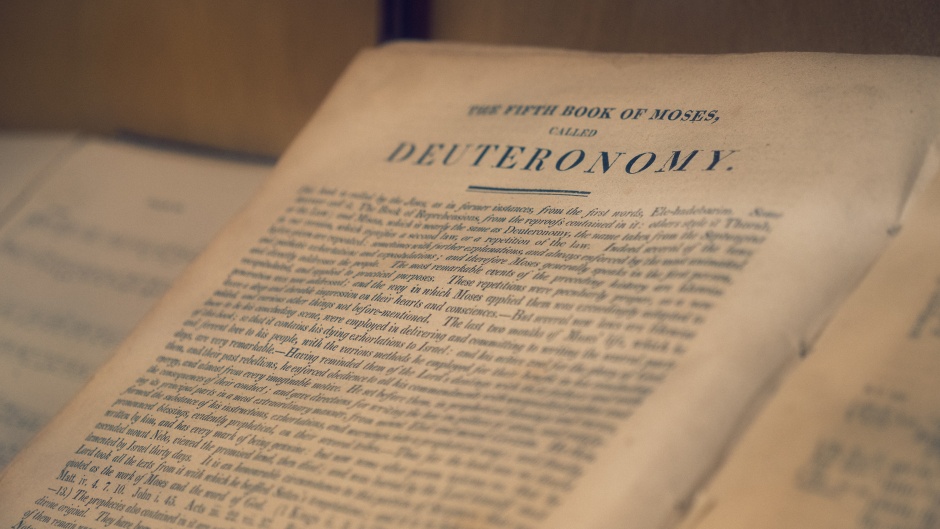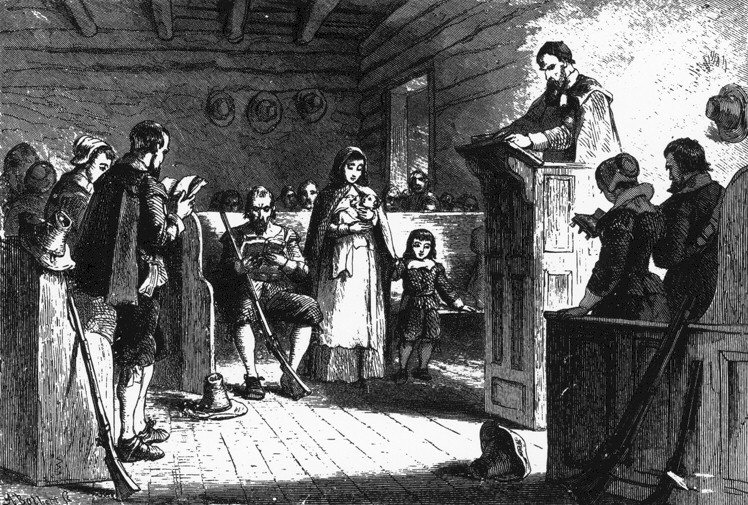Imagination in Preaching – W. B. J. Martin

“The mind of man is more like a picture gallery than a debating chamber,” said W. MacNeille Dixon in his famous Gifford Lectures, The Human Situation. Therefore, if our preaching is to be effective it must penetrate below the level of man’s conscious intellect and his official ideologies. It must speak to the unexamined assumptions, and the hidden images, symbols and pictures that a man entertains in the secret places of his heart, and which are often the real driving force of his personality.
As Amos Wilder has said in his Theology and Modern Literature, “Society lives by its symbols.… It is more important to discern the actual operative myths of civilization than the formal clichés of its political orators. A democratic society may proclaim its democratic dogmas, but the same society may be governed by undemocratic nostalgias and passions fed by obsolete dreams. The church itself may proclaim its Christian principles, but Christians may be ruled by sub-Christian images.”
The great preachers of every age have known this. They have not been like lawyers arguing a case, or salesmen pushing a product; rather have they been like poets seeking to suffuse the mind with light, to empower the emotions with the splendor of revelation, and so to capture the will for God. In the discharge of this task they have used all the resources of imagery, picture, parable and metaphor. For, as the Scottish poet Edwin Muir once put it: “Nothing is wholly real until it finds an image as well as a formula for itself. The image is the record that the conception has been steeped in the unconscious, and there accepted by the deeper potencies of the mind.”
- MARKS OF IMAGINATIVE PREACHING
Cultivating the imagination in preaching is more, much more, than collecting illustrations and anecdotes. It is rather a habit of mind, and a way of attending to the actualities of life. We are told in 1 Samuel 9:9 that “he that is now called a Prophet was beforetime called a Seer.” That is the first step in cultivating the imagination—to see what is before our eyes. Many men are so accustomed to gazing at the world through borrowed spectacles that they see only conventional stereotypes; they experience reality at second hand as it has been reported by others, and so their vision is a series of clichés. What made the old prophets such disturbing people was that they actually saw for themselves; they had a gift much rarer and perhaps more valuable than second sight, namely, first sight. And what made them such powerful communicators of their vision was that they reported it in concrete imagery, in the earth-laden speech of daily life, and in metaphors and analogies that were close to the soil and to the actualities of human existence.
The seer of Patmos was divinely counseled to “write the things which thou hast seen, and the things which are, and the things which shall be hereafter” (Rev. 1:19). No man has ever seen a long string of abstractions. Yet how much preaching is abstract, both in content and expression. In this regard we are all apt to be captive to our age. The novelist and teacher, Lionel Trilling, has said, “A specter haunts our culture—it is that people will eventually be unable to say, ‘They fell in love and married,’ let alone understand the language of Romeo and Juliet, but will, as a matter of course, say, ‘Their libidinal impulses being reciprocal, they activated their erotic drives and integrated them within the same frame of reference.’ ” This kind of “gobbledygook” is sometimes encountered in theological writing, as witness this choice specimen from a recent article in a learned journal, “It is not the people as a collectivity that is the resolvent term of the divine action; this reaches each man in the singular.” But even the best theological writing is apt to be abstract and conceptual, necessarily so. But the place for theological terms is the classroom, not the pulpit. Preaching will derive more strength and sap from the language of the Bible than from the language of the theologians, for the language of the Bible is concrete, earthy, and visual.
“Write the things which thou seest!” When we study the sermons of great preachers, we quickly discover that they have the gift of pictorial imagination. For example, when that fine Methodist preacher, Percy Ainsworth, wished to speak to his people of the incarnation, he did not use that abstract term; he said, “Christ is not God’s messenger, but God’s message.” When Peter Taylor Forsyth wished to warn his congregation of the perils of introspection, he did not use the current psychological jargon; he said, “It is better, and safer, to pray over the Bible than to brood over the self.” On the same subject, an old Rabbi once put it picturesquely, “Rake the muck this way and rake the muck that way, it is still muck.” Or again, when William Robertson Nicoll wished to indicate the desolating sense of loss he felt at the death of Charles Haddon Spurgeon, he told his public, “He has fallen like a tower, and there is a gap in the landscape of life.”
The great orators of our time have all cultivated the same poetic concreteness and particularity. Winston Churchill did not hearten the British people during the war by making general statements; he said “We will fight on the hills, we will fight in the streets, we will fight on the beaches … we will never surrender.” The wartime President of the American people had the same gift of vivid imagery. When one of his script writers produced a speech that read, in part, “We are trying to construct a more inclusive society,” the presidential blue pencil reshaped this to read, “We are going to make a country where nobody is left out.” The abstract “construct” became the concrete “make”; the general term “society” became the particular word “country,” and the colorless “inclusive” became the factual “where nobody is left out.”
In all these examples there are certain common factors. For one thing, the speaker uses as few words as possible. “The great secret of style,” said Robert Louis Stevenson, “is to omit.” Much preaching is altogether too wordy; the thought becomes smothered by the cotton-wool of verbiage. In this connection, it is wise to watch the use of adjectives. A careful stylist once said, “The adjective is always the enemy of the noun.” He meant that such general adjectives as “very,” “great,” and so forth, usually weaken the force of the word to which it is attached. If a crisis is always a “serious crisis,” what happens to the perfectly good word “crisis”? If we never refer to a danger except as a “great danger,” what connotation can we give to danger itself. Can there be a little danger?
For another thing, the speakers we have cited resolutely avoid the use of the passive voice, in favor of the active: they never say that “a thing was done,” but that “he did it”—which is a more vigorous expression.
But above all, they eschew abstractions! And here surely they are in line with the Bible, and with the Lord of the Bible. When Jesus spoke of sin, for example, he did not generalize; he dealt in particulars. He spoke of salt without savor, of light hidden under a bushel, of a son leaving home, of a builder neglecting the foundations, of a wedding guest too proud to enter into the spirit of the party, of a worshiper praying for show. These are timeless images which stir the imagination, alarm the conscience, and enlighten the mind.
When that sensitive Christian poet, Edwin Muir, sought to put his finger on the weakness of the pulpit of his boyhood memory, he said,
“The Word made flesh was here made word again”
and he called preachers back to the practical importance of the incarnation for preaching—to clothe our words in flesh, the flesh of palpable imagery and concrete speech. He reminded them that a sermon should be more like a poem than an abstract discussion, and that the preacher is more akin to the poet than to the propagandist or the salesman. Percy Ainsworth said, “When you watch a religion at work, you find a morality; when you converse with religion in its thoughtful moods you find a theology; but when you get to the heart of religion you find a song.”
The singer and the poet do not argue, they reveal. They do not exhort and upbraid, they uncover the nature of reality; they bring to light the hidden assumptions upon which men are actually living their lives, very often in flat contradiction to their official creeds. They aim to evoke the response of recognition. In the words of the playwright Arthur Miller: “What the dramatist works for is, to hear the audience say, not, ‘What happens next?’ or ‘Why?’ but ‘O God, of course!’ ”
Luther wrote to his friend Eoban Hess, “I am persuaded that without knowledge of literature pure theology cannot at all endure. There has never been a great revelation of the Word of God unless He first prepared the way for it by the rise and prosperity of language and letters. By the study of literature as by no other means people are wonderfully fitted to grasp sacred truth and to handle it skilfully and happily.” And surely one of the great gifts of literature is that we may learn to use words in such a fashion that that may march into the castle of Mansoul “as terrible as an army with banners,” and take that castle for the Lord of All Good Life.
- THE USE OF ILLUSTRATIONS AND POETRY
I have said that we do not become imaginative preachers by ransacking literature for “illustrations,” and certainly not by compiling an anthology of pious poems and moralizing anecdotes. This does not mean that we are never to use illustrations. But if we do we should observe certain rules. We should, of course, be careful to verify our references and quote with accuracy. But even more important, we should quote sparingly. Nothing lulls a congregation to sleep more effectively than the reading of a long and involved extract from somebody else’s work. Nothing is more boring than listening to a man attempting to outline the plot of a novel or a film or a play. If one wishes to quote the Shakespearean line, “Love is not love which alters when it alteration finds,” it is not necessary to quote the whole of the sonnet in which the line occurs, or to discourse on the “problem” of the Sonnets. In the case of such a well-known line it is not even necessary to say “As Shakespeare said,” and it is certainly not necessary to patronize the author by paying him superflous compliments, such as “the famous poet, William Shakespeare” or “that great genius, the Bard of Avon.” If one wishes to make use of the parable of the Grand Inquisitor in Dostoyevsky’s novel, The Brothers Karamazov, with its searing indictment of a religious organization that, in the name of Christ, brushes Christ aside in order to appeal to the masses, it is not necessary to quote the whole of that long and elaborately detailed parable, and certainly not to talk at large about the whole novel. It is sufficient to concentrate on the key passages. The view of the Grand Inquisitor was that “there are three powers, three powers alone, able to hold captive forever the consciences of these impotent rebels for their own happiness; these forces are Miracle, Mystery, and Authority.” So, out of genuine but ill-considered love for weak humanity, he goes on to say, “We have corrected thy work. We have founded it upon Miracle, Mystery and Authority, and men rejoice that they are brought again like sheep, and that the terrible gift [of freedom] that had brought them so much suffering was at last lifted from their hearts.”
In quoting poetry from the pulpit, it is wise to bear in mind a distinction that Vincent Buckley once made between “devotional verse,” which seeks to give easily remembered utterance to familiar religious sentiments without probing them, and poetry which is the utterance of the whole man, desperately engaged in realizing his covenant relation with God. Many devotional poems are poems of slack devotion, without any marshaling of the whole affective personality behind them. Religious poems, on the other hand, involve the entire man—believer and doubter at the same time, caught between the “mighty opposites” of heaven and earth, crying “Lord, I believe, help Thou my unbelief.” Many hymns are “devotional verse” at their best, but they lack the intensity of the poetry of a man like John Donne, with his:
Wilt Thou forgive that sin that I have done,
Which was my sin, though it were done before;
When Thou hast done, Thou hast not done,
For I have more.
The conclusion of that anguished poem reaches a crescendo rarely attained by the purveyors of easy sentimental verse that often passes for the real thing. Besides, it is not merely a “religious” poem, it is a Christian poem. That is, it probes, dissects, questions, affirms within the context of Christian revelation. It does not generalize in a devotional mood; it takes seriously the redemption offered to mankind in the incarnation, crucifixion and resurrection of the Son of God. Its intensity is due to its tension—the tension experienced between the reality and the promise, between the actual condition of man and the solution offered to him in Jesus Christ.
Fortunately in our day there are a host of poets who are writing from within the Christian drama; not peddling easy consolation or expressing vague nature mysticism or pious sentiments. What age has been so rich in literary men who are also committed Christians? Seldom has a single generation been able to call a roll so illustrious as T. S. Eliot, W. H. Auden, Edwin Muir, Christopher Fry, Allen Tate, Robert Lowell, John Betjeman, Elizabeth Jennings, and Phyllis MacGinley. These are all persons who are commanded by the Christian revelation, who seek to bring the “light of the knowledge of the glory of God” to bear upon the murk and obscurity of our times. But they do not so with facile ease. T. S. Eliot stabs us awake to the aridity and sterility of the “Waste Land” before he leads us out into the ample serenity of “The Four Quartets.” He has shown us with devastating clarity the land where the wind shall say:
Here were decent godless people:
Their only monument the asphalt road
And a thousand lost golf balls.
But in that “desert of the heart” he has pointed man to the vital meaning of the Christian faith for his life, in words that are understood by sophisticated modern people.
Similarly, the poet W. H. Auden, writing out of vast erudition and intimate acquaintance with the pilgrimage of twentieth century man, has brought alive in contemporary terms the existential significance of the incarnation in his Christmas Oratorio. Much of that long poem is not suitable for direct quotation from the pulpit (if only because like much modern poetry it is too close-packed with thought and imagery to be directly available at one hearing), but the insights afforded by the poem are invaluable for a preacher who wishes to relate the timeless gospel to his own age. Even so, there are memorable single passages which light up whole areas of experience:
We would rather be ruined than changed,
We would rather die in our dread
Than climb the cross of the moment
And let our illusions die.
When a poet like Edwin Muir returns in his maturity to the Christian faith, which, as he says, he now recognizes he had never left—or rather had never left him—he brings to its contemporary statement a freshness that many of us lack. There can be few men who have entered so deeply into the inner meaning of the doctrine of the second coming of Christ than Muir with his poem “The Transfiguration,” or seized with such contemporary relevance the meaning of the Word made flesh as in his poem “The Incarnate One,” or entered so personally into the Genesis story of creation as in the poem “One Foot in Eden.”
Horace Bushnell once preached a sermon he called “The Gospel: A Gift to the Imagination.” It is that, but it also requires imagination if it is to be presented effectively. It is here that the poets and dramatists and many novelists of our age can be our mentors and allies. They are not the source of the gospel, but they often probe more deeply the questions and problems to which the gospel is the answer and solution; and when they themselves are grasped by the gospel they can teach us how to set it to music, so that our hearers will learn to say, “Thy statutes have become my songs in the house of my pilgrimage.”
BIBLIOGRAPHY
Fowler, H. W., Modern English Usage. Oxford, 1965.
Gowers, Sir Ernest, Plain Words: A Guide to the Use of English. Knopf, 1954.
Hopper, Stanley R., Spiritual Problems in Contemporary Literature. Harper, 1957.
Mueller, William, The Prophetic Voice in Modern Fiction. Association Press, 1959.
Palgrave, F. T., The Golden Treasury. Macmillan.
Scott, Nathan, ed., The Tragic Vision and the Christian Faith. Association Press.
Wilder, Amos, Theology and Modern Literature. Harvard Press, 1958.
The works of T. S. Eliot, W. H. Auden, Edwin Muir, and Christopher Fry.
Martin, W. B. J. 1967. Imagination in Preaching. In R. G. Turnbull (Ed.), Baker’s dictionary of practical theology. (R. G. Turnbull, Ed.) (23). Baker Book House: Grand Rapids, MI

![AARON - The Anchor Yale Bible Dictionary 8 AARON (PERSON) [Heb ʾahărōn (אַהֲרֹן)].](https://difa3iat.com/en/wp-content/uploads/2023/07/Oo0un.jpg)

